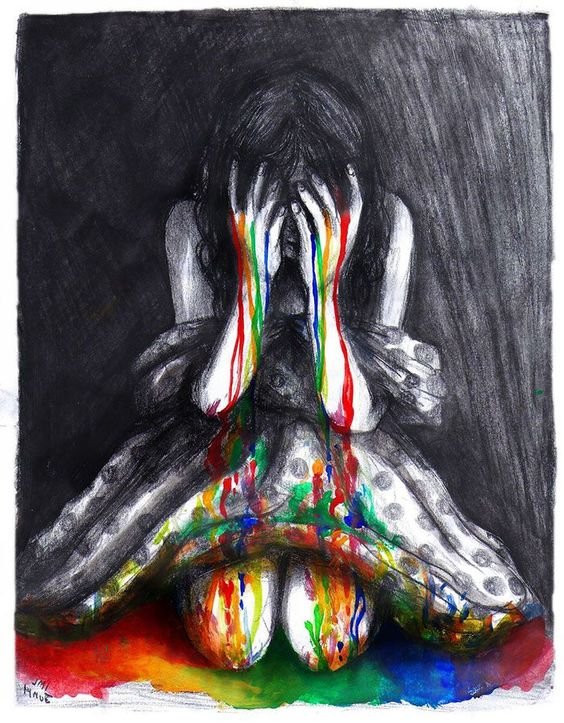Three suicide bombings have hit public opinion this week ... What drives a fashion designer or a famous programmer or young man who performs Umrah rituals to commit suicide?
Three suicide bombings have hit public opinion this week ...
What drives a fashion designer or a famous programmer or young man who performs Umrah rituals to commit suicide?
It is assumed that one of them owns money and another has fame and another religious faith ...
The seriousness of "depression" one, although multiple types, how to get rid of it?

Depression or depression is a mental illness in which the person suffers from sadness and negative feelings for long periods, and loss of enthusiasm and indifference; and encountered feelings of anxiety and grief and pessimism and guilt and chest tightness with the lack of a goal of life, making the individual lacks reality and purpose in life. The most common mental disorder is classified as mental disorders characterized by impaired mood. The most important characteristic of depression is the gradual decline - or the acute and sometimes accelerated - mood and dislike of activities. It can have a negative effect on a person's thoughts, behavior, feelings, world view and material well-being. Depression sufferers may feel sad, wanting to cry, worry, empty, lack of hope and value, helplessness, guilt, irritability, pain Moral, and turbulence. Many lose their enthusiasm and interest in work and social life and activities they liked. They may also suffer from anorexia or excessive eating. They have problems concentrating, remembering details and making decisions, and may harm, attempt suicide, or think about it.
Physical depression symptoms: Insomnia, excessive sleep, fatigue, lack of energy, pain, aches, digestive problems and other symptoms that do not respond to traditional treatment, may appear in patients with the disease.
Depression may not necessarily be a psychological disorder, but a natural reaction to specific life events, such as a symptom of certain medical conditions, or a side effect of certain medical treatments. Depression is also a key feature associated with psychological syndromes such as clinical depression.
the reasons:
Emotional tension, sad circumstances, painful experiences, and severe disasters (such as the death of a loved one or divorce).
Deprivation (and depression in response), loss of love and emotional support and loss of love or separation.
Unconscious conflicts.
Frustration, failure, disappointment, depression and anxiety.
The weakness of the highest ego and self-accusation and guilt is unforgivable for a previous behavior.
Loneliness, insomnia, menopause, deteriorating sexual sufficiency, aging and retirement.
Education is wrong

Haenuli, Korean artist, overcame her depression with illustration
When artists talk about their depression
New life
Events and life changes that may contribute to depression: menopause, physical difficulties, stress of work, problems of interpersonal relationships, separation, loss of loved ones, severe injuries,
Medical treatments
Some drugs are known to cause depression in a number of patients, such as the hepatitis C drug, and some drugs used to treat high blood pressure, such as beta blockers or researbin.
Non - psychological diseases
Depression may be the result of many infectious diseases and physiological problems including:
**chronic diseases
**Hypothyroidism (in men)
**And Addison's disease
**Lyme disease
**Multiple Sclerosis
**Sleep Apnea
**Biological clock disorder
It is often an early symptom of hypothyroidism (low thyroid activity) and chronic pain can also cause depression. To discuss non-psychotic conditions that can cause depression, see depression (differential diagnosis).
Psychiatric syndromes
Depression is associated with many psychological syndromes as a fundamental symptom. Mood disorders are a set of disorders that are the main mood disorders, including:
Primary depression (sometimes referred to as primary depression or clinical depression) is when a person suffers from depression and loses pleasure or interest in most activities for more than two weeks.
Partial depression, a mood disorder less severe than clinical depression but lasting longer than several years.
Severe depression: It comes in the form of fits or spells of depression only. This type of depression may be accompanied by psychotic symptoms such as hallucinations or hallucinations.
Bipolar disorder accompanied by a period or several periods of abnormal rise in energy levels and cheerfulness may be punctuated by periods of depression. When the seizures (depression, bipolar, etc.) follow a seasonal pattern we can describe it as a seasonal emotional disorder.
Mood disorders: Depression usually accompanies borderline personality disorder and edema. It is a mood disorder that appears as a reaction to a particular event or stress. Symptoms are behavioral and emotional, but do not meet the criteria for periods of depression. Post-traumatic stress disorder is a traumatic disorder that is usually accompanied by depression.
Types of depression :
Partial depression.
Great depression bout.
Light depression.
Acute depression.
Mental depression.
Symptoms of psychological depression
The symptoms of the following depression appear almost continuously for at least several weeks:
A depressed, sad or unhappy mood.
Aclear lack of desire or pleasure in all things that have aroused desire or pleasure.
Poor appetite for food or a significant decrease in weight can not be explained by a diet, increased appetite for food
or a noticeable increase in weight.Insomnia or tendency to sleep.
Feeling stressed and unable to relax or feel slow and physical heaviness.
Idle and energy loss.
Sense of inferiority, self-blame or feeling inferior.
The inability to think, concentrate or make a decision.
Frequent thoughts of death (not including fear of death), frequent suicidal thoughts.
Defective ability to perform social, professional or other functions.
Feel guilty and self-accusation.
The feeling of anxiety and the possibility of suicide is few.
Inclusion, withdrawal, unity, isolation and silence.
Loss of appetite and rejection of food.
Headache and fatigue for the least effort.
protection
Attention to the prevention of mental disorders is increasing.
Where research showed a decrease in the number of new depressions when people began to participate in interventions by 22% and 38% in the meta-analysis. In a study of patients with sub-threshold depression, patients who received a minimum level of psychotherapy experienced depression one year later (less than 7 percent of patients who joined control groups). These interventions are also economical and save a lot of money. * The Mental Health Care Center in the Netherlands provides a preventive intervention system such as the "Dealing with Depression" class for people with sub-threshold depression. A meta-analysis showed that those who followed this class had 38% less depression than those who joined control groups. Intensive care intervention (waiting and monitoring, cognitive behavioral therapy, and medication if required) resulted in a 50% lower incidence in the group of patients aged 75 years and above. A single study on depression found a neutral effect on personal, social, health, educational, and teacher progress. It included a comment about the possibility of increased depression in people who received cognitive behavioral therapy because of self-recognition and recognition of symptoms of depression and negative thinking patterns. Another study found a neutral result as well.
Diagnosis
We can identify the causes of depression through the patient's complete medical history, physical diagnosis and overall symptom evaluation. Standardized scandals may also be useful as the Hamilton Depression Scale and the Beck Depression List. The doctor usually performs specific medical tests to exclude any other causes of symptoms of depression, including tests:
Blood to measure the hormones of the thyroid hormone and stimulant hormones to exclude the deficiency of this gland.
Calcium screening to exclude metabolism disorders.
A comprehensive blood test involves analysis of blood deposition velocity to exclude any systemic infection or chronic diseases.
Negative reactions to drugs and alcohol abuse are usually excluded.
Testosterone levels can also be assessed for the diagnosis of gonadotropia, a potential cause of depression in men.
Self-cognitive complaints often appear in older depressed patients, but they can be an indicator of the onset of an updated dementia disorder such as Alzheimer's. [Dementia and depression can be distinguished by EEG and cognitive testing]. CT scans can differentiate between brain diseases and mental illness. Biological tests can not confirm depression and often do not repeat tests unless there is a medical signal to warrant it.
Cases
In youth
44% of American college students reported feeling depressed. These data indicate that the traditional age of university students is more likely to be depressed or depressed. Forty-four American colleges and universities use a random sample of 28,000 students from the American College of Health Associations (ACHI) and the National College of Health Assessment (NHA) each year. This questionnaire looks at the health and behavioral condition of students including symptoms of depression or depression in their previous school year. Based on the results, the rates of students who experienced depression rose from 10% in 2000 to 21% in 2011. Female students reported symptoms of depression, including 22% feeling hopeless, 23% feeling lonely, and 26% feeling sad During the two weeks preceding the questionnaire. Women are more likely to be depressed than men in 2011.
In adults
In the prisoners
The rate of mental illness in offenders is high, with recently estimated that between 50-70% of individuals in detention have been diagnosed with unipolar depression. The way in which depression is managed in prisons has been the subject of much debate. A US study of 5,305 Texas prisoners diagnosed with depression indicated a significant difference in describing the patterns and use of psychosocial interventions between prisons. The study also showed that more than a fifth of patients with depression remained untreated despite confirmation of the diagnosis. "Even the best prisons with the best systems and the most committed workers suffer in an environment where anxiety and depression do not flourish," said John Bodmore, former head of prisons, public and transitional facilities. It is important that physicians and health care personnel with patients within the criminal justice system evaluate and manage patients with depression effectively, and make sure that the underlying biases they may feel do not affect the care they provide. All pharmacological and non-pharmacological treatments should be provided to prison patients in the same way that treatments are provided to other patients in accordance with UK clinical guidelines.
Methods of Treatment
It is very important to know that there is no immediate solution to problems in life. Solving problems takes time, energy and effort. In therapy we should not look at mind, soul, and body as separate units, but rather as a unit. The mind can not be manipulated away from the soul and soul.
Self-treatment for depression
A recent scientific research has shown that the smile affects the arteries that nourish the brain and the blood flow to it, which gives the person a calm and a sense of joy and pleasure
A recent study shows that friendship protects you from depression. Friends also help reduce the risk of heart disease and promote the immune system. Friends are protection against stress and depression.
Psychiatrists recommend psychologists and psychologists to get along with other people with depression. This may help to remove feelings of isolation and at the same time see how others can overcome their difficulties. Finding that you can help others may help you too. These groups are usually led by people who have overcome depression themselves.

Par SmileGirlhdz
https://www.wattpad.com
Social Therapy
It is a treatment shared by the environment surrounding the depressed of parents and brothers and educators and mentors and specialists and requires self-response of those suffering from the imposition of these symptoms.
- Dialogue -
Psychological Counseling -:
Someone with a coach is listening to art. Which allows the patient to express his feelings. Talking and listening by someone - showing understanding and acceptance may help the patient to discover things that are bothering him. A psychologist may be able to help gain a deeper understanding of feelings, thoughts and behavior. Helps you find ways to overcome the problems you are experiencing. It aims to provide you the opportunity to work on life in a more satisfying and productive way. You may be encouraged to look carefully at your past, especially your childhood and your relationships with people who have had a significant impact on your life. It helps you to understand the problems and overcome emotional difficulties. The wizard enables you to find connections between your thoughts and how your thoughts affect you and your behavior.
Most people need depression is someone who takes care of them. Praise is more effective than criticism. You can remind them that they can do things to improve their position, but you have to do this carefully and kindly to have an effect.
- Drugs:
It does not treat depression, but it certainly relieves symptoms so you can do something to deal with depression yourself. Antidepressants do not work with everyone and cause undesirable side effects. It usually takes two to four weeks before the medication is taken. Some antidepressants may be dangerous when used with other drugs, and may suffer from the effects of withdrawal of the drug when you stop taking it. It is useful to mention that there is a certain type of drug called monoamine oxidase inhibitors that should not be taken with certain medications or foods because of serious health problems. So you should have information about the medicine you are taking either by reading the attached leaflet or by contacting the Drug and Toxic Information Centers.
- Electro shock therapy:
But have negative effects on the brain and can shock the person for only three times
- Phototherapy
Between 15 and 25 percent of people with recurrent depression disorder show a seasonal pattern where symptoms worsen during the winter months and subside during spring and summer. DSM-5 identifies this disorder as a depressive disorder, recurrent, with a seasonal pattern. It has been commonly known as seasonal mood disorder depression. Bright has suggested light therapy as a first-line treatment for "blues" and as an adjunct to chronic MDD or depression with seasonal exacerbations (Carraso et al., 2006). SAD is believed to be related to the presence of melatonin, which is produced by the pineal gland. Melatonin plays a role in regulating the biological rhythms of sleep and activation. It is produced during dark cycle and closes in daylight. During the darker hours of longer hours, there is increased production of melatonin, which appears to lead to SAD symptoms in exposed people.
It has been shown that light therapy, or light exposure, is an effective treatment for depression. Light therapy is administered by a light box of 10000 lux, which contains white fluorescent tubes covered with a plastic screen that prevents ultraviolet radiation. The individual sits in front of a square with open eyes (although they should not look directly into the light). Treatment usually begins with 10- to 15-minute sessions, progressing gradually to 30 to 45 minutes. Some people notice an improvement quickly, within a few days, while others may take several weeks to feel better. Side effects are related dose, include headaches, eye fatigue, nausea, irritability, light phobia (light sensitivity to light), insomnia (when using light therapy late in the day), and rarely mild mania (Terman & 2005). Light treatments and antidepressants have shown similar efficacy in cataract therapy studies. One study compared the efficacy of cataract light therapy to daily treatment with 20 mg of fluoxetine (Lam et al., 2006). The researchers concluded that "mild treatment showed the onset of early response and decreased rate of some adverse events for fluoxetine, but there were no other significant differences in results between light therapy and antidepressant drugs.


Resteemed your article. This article was resteemed because you are part of the New Steemians project. You can learn more about it here: https://steemit.com/introduceyourself/@gaman/new-steemians-project-launch